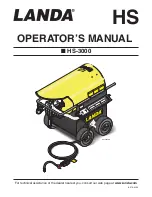
6
10.
Replace the overpressure plug if it is hard, deformed, cracked, worn or pitted, or when replacing the sealing ring.
— The
overpressure plug is designed to relieve excess pressure by releasing from the cooker cover in the event that both the vent pipe and
pressure relief valve are blocked. The overpressure plug is made of rubber, and when new, is soft and pliable. Over time, depending
on the frequency and type of use, rubber becomes hard and inflexible. when hard and inflexible, the overpressure plug loses its ability
to act as a secondary pressure relief valve. It should be replaced immediately.
Should the overpressure plug ever be forced out of the cover due to excess pressure while cooking, it is important to call the Test
Kitchen at 1-800-368-2194.
Do not attempt to use the released overpressure plug
.
11.
Always follow special procedures found in the instruction book when pressure cooking rice, grains, and dry beans and peas.
During cooking, dry beans and peas tend to froth and foam which can cause the vent pipe to become blocked. Therefore, dry beans
and peas need to be soaked and cooked according to instructions on page 23. Using this method will keep foam at safe levels during
cooking. Like dry beans and peas, rice and grains tend to froth and foam during cooking; therefore, to contain foaming and frothing
during the cooking period, rice and grains must be prepared in a bowl in the pressure cooker according to directions on page 25.
CleanInG
1. All parts of your pressure cooker, including the sealing ring and pressure regulator, are
fully immersible for easy cleaning. when washing the unit, however, the sealing ring
should always be removed to allow easy cleaning of the inside rim of the cover.
Your stainless steel pressure cooker may also be washed in an automatic dishwasher.
when washing in a dishwasher, you must first remove the sealing ring from the cover
as this part must be hand washed.
The sealing ring should be washed in hot, sudsy water after each use.
2.
If food residue adheres to the pressure cooker body, clean with a stainless steel scouring pad, a
nylon mesh pad, or a non-abrasive powder cleanser, such as Bon ami* polishing cleanser or Cameo*
copper, brass & porcelain cleaner. Do not use steel wool or cleaners with chlorine bleach.
3. To be sure the vent pipe is clear, hold the cover up to the light and look through the vent pipe.
Clean it with a small brush or pipe cleaner if it is blocked or partially blocked (Fig. N). Also clean
the vent pipe nut as shown.
4. Occasionally remove the air vent/cover lock in the pressure cooker cover handle for cleaning.
To remove the air vent/cover lock, place your finger over the hole in the cover handle (Fig. N) and
remove the white rubber gasket from the air vent/cover lock on the underside of the cover (Fig. O).
Push the air vent/cover lock through the top of the cover and wash it and the gasket in hot, sudsy
water. The metal shaft of the air vent/cover lock may be cleaned with a nylon mesh pad. Clean
the hole in the cover handle with a small brush. After cleaning, reinsert the metal shaft of the air
vent/cover lock from the top side of the cover down through the cover handle hole (Fig. P). Place
a finger over the handle hole (to keep the cover lock from falling out) and turn the cover over. wet
the rubber gasket and push onto the end of the metal shaft until it snaps into the groove on the shaft.
5. The overpressure plug can also be removed for cleaning by pushing it out of its opening from the
top of the cover. After cleaning, reinsert it by pushing the domed side of the plug, marked “TOP
”,
into the opening from the underside of the cover, until the bottom edge is fully and evenly seated
against the underside of the cover (Fig. Q). when the overpressure plug is properly installed, the
word “TOP” will be visible on the overpressure plug when viewing the outside of the cover.
6. The pressure relief valve should
not
be disassembled for cleaning or repair. Clean the exposed
surface of the valve when cleaning the underside of the cover.
7. To bring out its luster, the outside surface of your stainless steel pressure cooker can be cleaned
occasionally with a silver polish or any other fine, non-abrasive polish.
Take care not to overheat your stainless steel pressure cooker. Very high heat can sometimes cause varicolored stains, called heat
tints, in stainless steel. Heat tints can usually be removed by using a non-abrasive powder cleanser.
Care and maInTenanCe
1. when not in use, store your pressure cooker in a dry place with the cover inverted on the body. If the cover is locked on, unpleasant
odors may form inside the unit and the sealing ring could be damaged.
*Bon ami polishing cleanser is a registered trademark of Faultless Starch/Bon Ami Co. Cameo copper, brass & porcelain cleaner is a registered trademark of Church &
Dwight Co., Inc.
Fig. N
Cover
Handle
Hole
Metal
Shaft
Cover
Handle
Hole
Fig. P
Fig. O
Rubber Gasket
Indented Portion
Overpressure Plug
Fig. Q







































